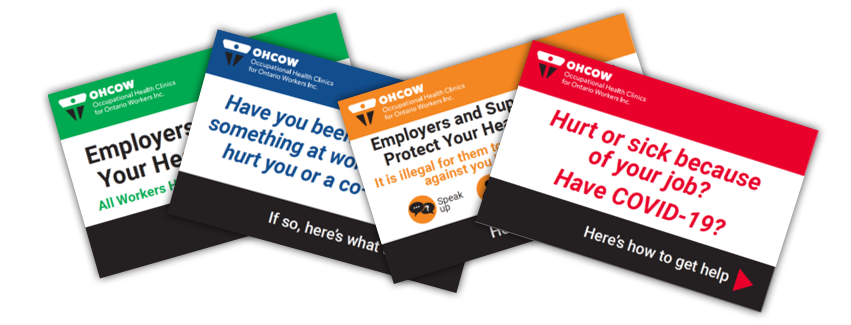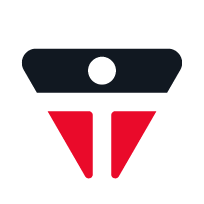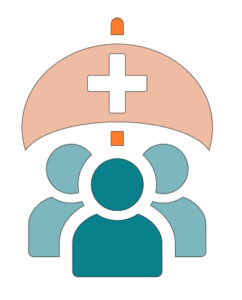 Occupational Illness
Occupational Illness
Occupational illness and its prevention requires engagement and action at all levels of the Prevention System and beyond – from communities, families, workers, managers, safety reps, owners, safety professionals, health care providers and regulators.
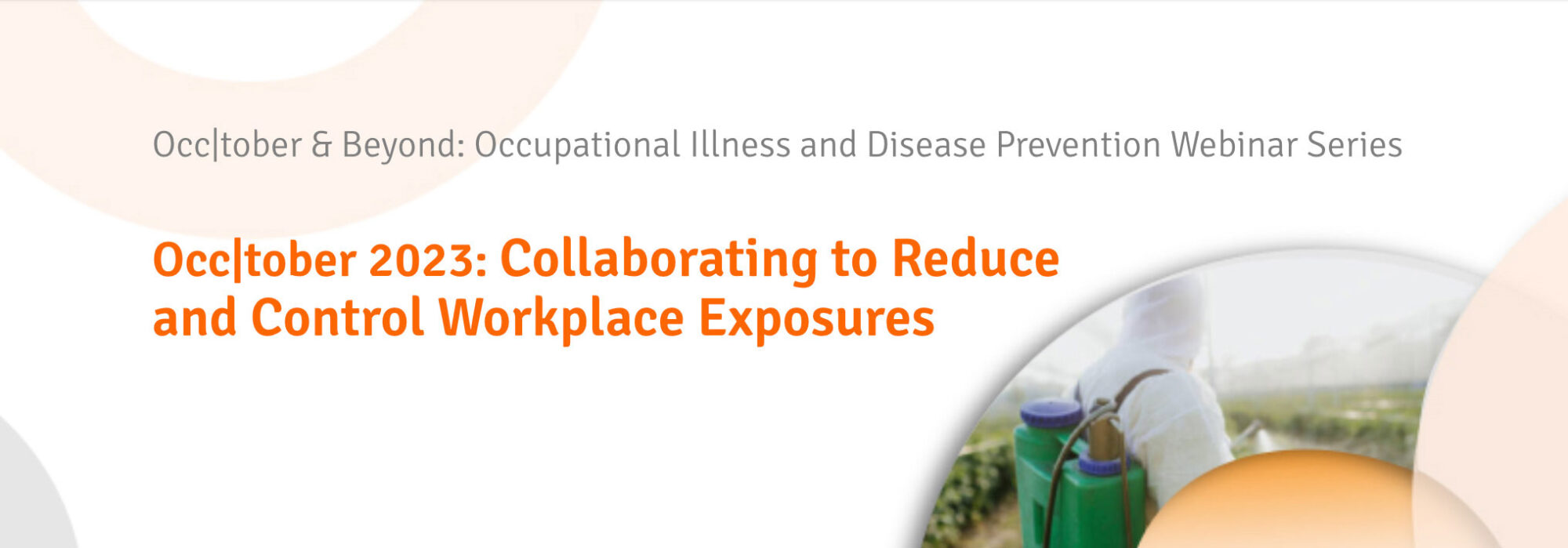
Occ|tober 2023: Collaborating to Reduce and Control Workplace Exposures
October 27, 2023
Finding Evidence for Exposures of Concern
Kicking off the 2023 installment of our Annual Occ|tober Webinar Series, the first webinar focusses on finding evidence for exposures of concern. Expert advice on what to do about potential dangers posed to workers from exposures to hazardous substances is presented. Topics include the EKOS/OHCOW Workplace Exposure Survey, Is Silicosis Making a Comeback? and Evidence for New Occupational Exposure Limits.
November 3
Launch of the Ontario Silica Control Tool & Ontario’s OHS System Focus on Occupational Illness Prevention
Beginning in November 2023, workers and employers in the construction industry will receive full, free access to the Silica Control Tool, recently updated for use in Ontario. An introduction from Dr. Joel Moody, Chief Prevention Officer, MLITSD, starts the session. An informative presention on the Tool was presented by the OHCOW team. The second part of the session discusses a Policy Update on the 5 yr Prevention Strategy and OCRC Exposure Research Analysis of TTC Subway Exposures.
November 10
Ontario Occupational Disease Landscape Review Highlights, and the ECHO OEM Tools for Primary Care to Get Work Done!
Dr. Linn Holness, MHSc Scientist and Director of CREOD, and Janet Brown, discuss prevention and healthcare in the occupational disease landscape. Dr. Anil Adisesh, Dalhousie University, discusses the ECHO OEM Occupational and Environmental Medicine (ECHO OEM), a telementoring program for primary health-care providers in Ontario.
November 17
Exposures & Disease – Making the Link
Hosted by Krista Thompson, a video by Mark Parent on Nickel Exposure starts off the session. Occupational Hygienist Masood Ahmed speaks about Dermal Exposure Overview including sampling, results and prevention. Derrick Chung presents a case study in Dermal Exposure and illustrations of conceptual models in a discussion of DREAM: Dermal Exposure Assessment Method. OHCOW Sarah Rhodes speaks about case studies in the Rubber Industry, specifically in the Kitchener/Waterloo region.
November 24
Airborne Hazard Management Programs- Reducing Exposures in Mining

This session informs employers, workers, and other workplace parties to develop and implement an airborne hazard management program (AHMP). Practical information in reducing exposures as part of the AHMP is provided. The topics of monitoring of ambient and workplace air, and a method including real time monitoring of diesel particulate matter (DPM) are discussed. Reports on updated mining legislation, engine certification, monitoring diesel particulates and developing an occupational monitoring plan and exposure risk evaluation and more are included.
Protecting Workers' Health in the Construction Industry
On November 3 2023, Occupational Health Clinics for Ontario Workers introduced the Silica Control Tool (SCT) a tool that will help protect workers from lung disease caused by inhaling the dust of crystalline silica, which is found in sand, rock, gravel, concrete, brick, stone, mortar, granite, glass, ceramics and many other materials. This is year one of a five-year plan. The Tool’s user interface has undergone a facelift for Ontario and has been fully customized to meet Ontario’s health and safety regulation and standards. The SCT is available at no charge to any worker or employer at risk of exposure to silica dust, the tool is easy to use and can be downloaded to a phone, laptop or desktop.
Dr. Joel Moody, Chief Prevention Officer/ Assistant Deputy Minister, Ministry of Labour, Immigration, Training and Skills Development, said on the day of the launch that "The Silica Control Tool will help empower employers and workers - from workplaces and operations of all sizes - to understand the hazards and prevention strategies related to working with silica. I want to recognize and thank OHCOW for their leadership to make this project happen."
OHCOW sent a media release and launched a social media campaign to inform the construction industry of the new tool and provide links to OHCOW's SCT page. This page features more information, instructions and links to register. The response to the social media posts saw a 50%+ increase in reactions, including "likes" and favourable comments.
Through a special budget, the project hired an external media company that helped to draw increased traffic to the web page, and created materials such as banners, infographics, posters, walllet cards and stickers.
A sample of the ads placed on social media, that linked to the SCT landing page on OHCOW's website:
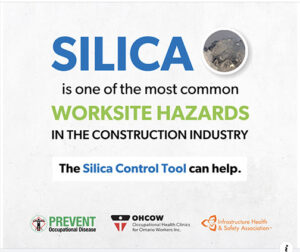 |
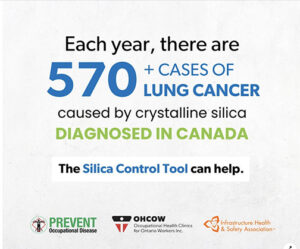 |
 |
 |
The boosted posts resulted in more than 14,000 visits to the landing page. The registration page has more than 28,000 visits to date.

Friday June 23
Understanding Post-COVID-19 Condition in Canada
Dr. Sarah Viehbeck, Chief Science Officer, reports what we know, don’t know, and a framework for action: Research, Patient/Family Support & Preparedness. What can we do in workplaces to recognize, assess and control the hazards that contribute to COVID-19 infection and prevent and mitigate the associated harm? Hosted by Kevin Hedges, Ph.D, CIH, COH, Occupational Hygienist, OHCOW Eastern Region/Ottawa Clinic.
Friday August 25
Let's Collaborate on Solutions for Cleaner School Air!
Better ventilation and air quality means better health for children and reduces virus spread. This popular session includes a look at recent Australia experience, efforts and guidance plus how standards for cleaner air can be leveraged, all framed by an introduction to grassroots school safety advocacy efforts from across the country.
Friday, October 6
Managing Mixed Immunity and Related Infection Risks
This session seeks to unwrap the complexity and variety of factors affecting risk of acute and chronic impacts in the context of workplace prevention strategy. Professor Dawn Bowdish, PhD discusses her research on individual and age group immune susceptibility, and how it can be applied to workplace prevention.
Friday, January 30
OCC-COVID Webinars 2024: Health Care Impact, Lessons and Choices
The ever-present SARS CoV-2 virus (and its endless mutations and "wicked" complexity of disease) seem impossible to solve. Understanding the personal and societal impact can drive a perspective shift that allows each of us to find and implement transmission control and harm mitigation strategies that can make a difference in our home, work and recreational activities.
Occ-COVID Year 5
Managing Mask Madness – Benefits, Challenges & Solutions
Masks are a key tool in the fight against aerosol hazards, but much maligned and misunderstood. Review latest research, controversy & new CSA standard. Masks and respirators have been key tools in worker protection and infection control for decades, yet they have become objects of ridicule and extensive mis-information. This session discusses their efficacy and use parameters to maximize their effectiveness in our illness prevention toolkit.
Above is a grouping of resources featured in the Heat Stress Toolkit. It includes pamphlets, infographics, videos calculators and pdf materials in multiple languages.
Some infographics in this series include:
Heat Stress Risk Factors
Heat Stress Symptoms
Heat Stress Warning Signs
Heat Stress Effects
Heat Stress Acclimatization
Heat Stress Response Plan
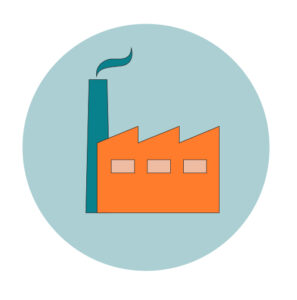 Cluster Projects
Cluster Projects
An Occupational Disease Cluster Investigation is opened at the request of an individual, a worker organization or a community group when a cluster of workers from a shared workplace or industry experience the same health conditions. OHCOW identifies exposures that should be reduced or eliminated, screens workers for early signs of disease can be detected, and helps workers and families to file claims and provide relevant medical assessments.
Rubber Worker Project 2024 Update
OHCOW’s project staff have continued to collect information about the layout of the plants, the chemicals used in specific areas and jobs, working conditions, Ministry of Labour inspection reports, product information (data) sheets, studies about the hazards and health effects of rubber work and other relevant information. We’ve talked to former union leaders and health and safety activists and connected with the members of the “BF Goodrich employees” Facebook page. We are working with the Office of the Worker Advisor (OWA) and the Steelworkers to get information they may have. We have been to several libraries, looking for photographs and documents to assist with cases and to update the website. In March of 2024 a letter addressed to Rubber Workers and their families is being presented by OHCOW to update all concerned.
The Project database now has 282 workers, many with multiple WSIB claims. It includes information about the worker’s health condition(s), job history and claim status. We are creating another database to connect individual claims to relevant studies and other information that can help new and existing claims. OHCOW staff have reviewed the files we have for WSIB claims involving rubber workers. This chart summarizes what we know about them.
This review is improving our understanding and, in some cases, could lead to finding additional or new evidence to support individual claims.
For more information, read the letter from Valerie Wolfe, OHCOW Executive Director, South Central Region.
General Electric Peterborough Project 2024 Update
Our team has continued to gather and review available medical and work history records for individual GE clients. We also research and review available evidence from scientific studies and clinical literature of health conditions that have links to past workplace exposures at GE Peterborough.
What did we accomplish this year?
We conducted outreach to workers and their next-of-kin.
- We mailed project update newsletters to workers and their families.
- We conducted follow-up outreach to workers or their next-of-kin through phone calls and/or letters.
- We supported workers and their families to navigate the WSIB claims process, including assisting with the initial paperwork to file claims, and linking workers with worker representative services for claims.
We completed foundational work on sentinel cases of esophageal, colon, and lung cancer in support of GE workers WSIB compensation claims.
- Through this foundational work OHCOW hygienists were able to create an OH report template, for each diagnosis related to exposures experienced by GE workers, using standardized text and a thorough examination of all available information. This approach will allow for timely, concise, and consistent exposure assessments of similar types of denied claims.
We built a stronger new collaboration with the Office of the Worker Advisor (OWA).
- OHCOW and OWA has jointly designed a shared case tracking list stored in a secure location where both organizations can update in real-time to greatly improve communication and transparency to better help the injured workers we serve.
What’s coming next?
- We plan to conduct extensive worker outreach in 2024-2025 through follow-up phone calls and letters to workers or their next-of-kin, to update your information and determine what further supports we can provide.
- We will continue reviewing the individual client files of GE workers with our interdisciplinary team in collaboration with the OWA.
- We will continue to support workers to complete the initial paperwork to start workers’ compensation (WSIB) claims for health conditions related to their workplace exposures, and to link them with services from the Office of the Worker Adviser to represent them on claims and appeals.
We want to hear from you!
- Did you or your family member work at General Electric in Peterborough?
- Do you have concerns about the impact of your work on your health?
- Contact OHCOW for further information or to register with us as part of our GE Peterborough worker cohort.
McIntyre Powder Project 2024 Update
McIntyre Powder (finely ground aluminum dust) was administered to mine workers in Ontario in most gold and uranium mines between 1943 and 1979, under the mistaken belief that it would prevent the lung disease silicosis.
Since 2016, OHCOW has been actively investigating the health issues linked to McIntyre Powder and multiple other mining exposures experienced by Ontario mine workers, such as diesel engine exhaust, respirable crystalline silica, lubricants, ionizing radiation, arsenic, solvents, dusts, fumes, and more.
What did we accomplish this year?
We conducted outreach to workers and their next-of-kin.
- We mailed project update newsletters to workers and their families. Read the latest information about Research, Medical Updates, WSIB Policies March 2024 Issue
- We conducted follow-up outreach to workers or their next-of-kin through phone calls and/or letters.
- Our team hosted a public (virtual) information session regarding cardiovascular disease and McIntyre Powder exposure in February 2024.
- We supported workers and their families to navigate the WSIB claims process, including assisting with the initial paperwork to file claims, and linking workers with worker representative services for claims.
- Information about OHCOW services, including OHCOW reports on mining exposures and health, was provided during in-person public outreach sessions through our community partner (McIntyre Powder Project), in Red Lake, ON in September 2023 and in Sudbury, ON in November 2023.
We finalized reports relevant to mining exposures and health and made them available to the public to support workers’ compensation claims.
- We provided our MP mine workers (or their legal next-of-kin) with individual medical and occupational hygiene reports addressing their specific work exposures and health issues. These reports supported the pursuit of individual WSIB claims.
- We built new infrastructure to support our ongoing client work.
- We finalized and published to our website the following in-depth reports dealing with scientific evidence linking mining exposures with health issues, and addressing WSIB policies and guidelines for claims decisions:
- Lung Cancer and Exposures in Ontario Hard Rock Mines;
- Radiation (Radon) in Ontario Uranium Mines: WSIB Policy, Exposure Data and Risk of Lung Cancer;
- Review of the Workplace Safety and Insurance Board (WSIB) Adjudicative Support Material Binder (ASMB) for Chronic Obstructive Pulmonary Disease (COPD) used in the adjudication of claims from Ontario miners;
- Idiopathic Pulmonary Fibrosis: Occupational Exposures as a Risk Factor.
- We converted all of our MP client files to electronic format, to make it easier for our multidisciplinary team to collaborate on our individual client work and our investigation of health and exposure issues common to multiple clients within the McIntyre Powder (MP)-exposed group.
What’s coming next?
- We plan to conduct extensive worker outreach in 2024-2025 through follow-up phone calls and letters to workers or their next-of-kin, to update your information and determine what further supports we can provide to you.
- We will start the process of reviewing the individual client files of our MP workers who were diagnosed with cardiovascular diseases, to determine if their work exposures, including to McIntyre Powder, may be linked to the development of their cardiovascular disease.
- We will continue to support workers to complete the initial paperwork to start workers’ compensation (WSIB) claims for health conditions related to their mining exposures, and to link them with services from the Office of the Worker Adviser to represent them on claims and appeals.
- We will continue our ongoing work to gather, compile, and review individual client medical and work history records, and to provide individual reports to workers regarding the contribution of their work exposures to the development of their health issues.
We want to hear from you!
- Did you or your family member work in Ontario mines that used McIntyre Powder?
- Do you have concerns about the impact of your work on your health?
- Contact OHCOW at 1-800-461-7120 for further information or to register with us as part of our group of McIntyre Powder-exposed mine workers.
Ventra 2024 Update
What did we accomplish this year?
- We mailed project update newsletters to workers and their families.
- We continued to conduct health and work and exposure interviews with workers and their families.
- We have conducted reproductive questionnaires with Women who have expressed that they have expressed reproductive health concerns.
- We supported workers and their families to navigate the WSIB claims process, including assisting with the initial paperwork to file claims, completing the Workplace Safety and Insurance Board Intent to object Form (ITO) and actively collaborating with Unifor Local 1987 and The Office of The Worker Advisor(OWA)
What’s coming next?
- We intent to carryout through worker outreach in 2024-2025 by conducting follow up calls and update letters to workers and their family members. The purpose is to update their health information and assess how we can offer additional support to the Pebra/Ventra Plastics workers and their families.
- We will continue our ongoing work in the collection, compilation, and examination of the individual client files, medical and work and exposure history. We will further review client files and provide reports detailing the correlation between the workers work and exposure and the onset health issues.
- We will continue to work with our Interdisciplinary team to review files and provide reports to the workers or estates legal representatives to submit to The Workplace Safety and Insurance Board(WSIB) on their behalf.
- We held an information session in Peterborough on March 26th and provided the workers and their family members with an update on the project, introduced the Occupational Health Clinics for Ontario Workers (OHCOW) and provided information on how to file a claim with The Workplace Safety and Insurance Board(WSIB) if they have a illness that they believed may be related to their Occupational Exposures
We want to hear from you!
- Did you or your family member work at Pebra/Ventra Plastics
- Do you have concerns about the impact of your work on your health?
- Please Contact our Occupational Health Coordinator, Jessica Montgomery at 1-613-218-7345 for further information or to register with us as part of our group of Ventra Plastics Project
Contact:
Jessica Montgomery at 1-613-218-7345
OR: 1-877-817-0336
EMAIL: peterborough@ohcow.on.ca
*Calls and inquiries are completely confidential
For workers with reproductive health concerns:
Concerns have been raised about reproductive health issues among Ventra workers. Are you experiencing any of the following?
- Endometriosis
- Uterine fibroids
- Excessively painful periods
- Excessive menstrual bleeding
If so, please reach out to the Occupational Health Clinic for Ontario Workers (OHCOW) to participate in our reproductive health survey.We are investigating potential linkages to workplace duties or hazards.
Dryden Project 2024 Update
Weyerhaeuser RB4 Project
The Dryden Weyerhaeuser Recovery Boiler #4 (RB4) project involves retrospectively assessing the health risk, and exposure profiling, for workers exposed to “un-scrubbed” stack emissions from the recovery boiler project work which occurred between 2002 and 2004. The RB4 construction project involved about 400 workers from various trades.
Apart from indication that some workers may have suffered from chronic toxic encephalopathy (CTE), there were numerous health effects reported via an intake clinic held in 2004 at Thunder Bay. Since 2004, OHCOW has been actively investigating worker health issues, that have been linked to the exposures such as for example CTE. CTE usually represents a chronic persistent diffuse injury to the brain resulting from cumulative or repeated exposures (often over a period of months or years).
Information has been collected in the follow up years from both records including anecdotal information. The OHCOW project also has been meeting monthly with the Dryden RB4 Committee and the Thunder Bay and District Injured Workers Support Group (TBIWSG).
What did we accomplish this year?
- Several cases have been selected for exposure profiling. Background records have been compiled for these individuals, along with pertinent information such as the chemical constituents of emissions necessary for sentinel retrospective exposure reviews (RER). There is a cocktail of chemicals associated with un-scrubbed paper mill emissions and understanding the chemistry and levels of exposure are critical to determine causation and linkage with illnesses and injuries reported such as CTE.
- Information from all of the prior investigations and approximately 840 records have been centralised. A master list of over 450 workers have been compiled, and many files have been reopened.
- A working relationship has also been cemented with the Thunder Bay and District Injured Workers Groups in addition to providing instruction in the WSIB processes to pro bono law students associated with the project. More recently during 2023 and 2024 OHCOW has participated in monthly committee meetings regarding the Dryden Project with the Thunder Bay and District Injured Workers Group to align our work and synthesize activities.
- Two public information sessions were also hosted in June and November 2023 with active participation by volunteers and OHCOW.
What’s Coming Next?
The next steps for this project include:
- Carrying out an up-to-date literature review to evaluate the latest evidence linking exposures to paper mill emissions with adverse health effects including CTE.
- Finishing working on the sentinel cases as this may encourage more workers to come forward and pave the way for others to submit claims with similar health complaints.
- Continuing to participate in committee meetings and town hall meetings to engage new workers and assist with the planning for an in-person town hall meeting.
- Continuing to follow-up with workers and assist wherever possible as they navigate the WSIB claims process. Also, connect them to the OWA where appropriate.
- Continuing to open files for any new workers that come into this project and add them to our active worker section on the master list.
We want to hear from you!
- Did you or a family member work on the project between 2002-2004?
- Do you need assistance with opening an RB4 WSIB claim?
- Do you need direction on how to appeal a denied WSIB claim?
- Are you experiencing neurological and/or other illnesses that you feel are due to your workplace exposures?
- Contact OHCOW at 807-623-3566 for further assistance or feel free to complete the questionnaire on our Cluster Projects web page (link below)
Algoma Steel 2024 Update
Background
Algoma Steel, (formally Essar Steel) was founded in 1902, and is the largest employer in Sault Ste Marie and the second largest Steel producer in Canada. Algoma Steel currently employees more than 2,700 unionized workers of United Steel Workers Local 2251 (USW Local 2251) and United Steelworkers Local 2724 (USW Local 2724). Their products are used in automotive, construction, energy, manufacturing, tube and steel distribution industries.
In May of 2008, USW Local 2251 held a 2-day Occupational Disease intake clinic in collaboration with the Occupational Health Clinics for Ontario Workers (OHCOW). Workers and their families had approached the union after being diagnosed with various Occupational illnesses. At the time of the intake clinic, Sault Ste Marie had four times the provincial cancer rate, according to the Algoma and District Health Unit and the Workplace Safety and Insurance Board (WSIB) statistics. USW Local 2251 members accounted for 3% of the provincial Occupational Disease fatalities registered with WSIB.
540 USW Local 2251 members and their families attended the intake clinic on May 7th and 8th. After the clinic, they held five additional mini-intake sessions surveying an additional 193 workers. As a result, 1,165 claims were filed by USW Local 2251, 261 claims were allowed and 596 were denied. These denied claims were continued to be worked on by USW Local 2251, and files continued to be referred to OHCOW.
Intervention/Approach
In 2022, OHCOW reopen the Algoma Steel cluster investigation project. OHCOW established an interdisciplinary team to review the previously denied claims. Letters were sent to past clients and workers who attended the intake clinic in 2008 re-offering services. The OHCOW team commenced consent calls, requested WSIB claim files and are reviewing the WSIB claim files and moving the cases through interdisciplinary consult meetings. We will review the literature and/or law and legislation and determine if these previously denied claims can now be supported.
The risk factors for cancer and various illnesses are multifactorial. For the patient to be entitled to benefits, a causal relationship between the occupational exposure and the diagnosis must be demonstrated. Lung Cancer and Chronic Obstructive Pulmonary Disease (COPD) is the most predominant illness to come out of the Algoma Steel Cluster investigation project. Workplace exposures of asbestos, silica, coke oven emissions, respirable dusts etc. continue to be reviewed by our hygienists.
At this time our Algoma Cluster investigation team continues to work through files that have been reopened as well as newly referred files, this is an ongoing project. In 2024-2025, we will continue to contact workers or their next-of-kin through follow-up phone calls and letters to update their information and determine what further support can be provided. As part of our ongoing work, we will continue to obtain, compile, and review medical records and work histories of individual clients, and we will develop individual reports regarding the contribution of work exposures to health issues.
We want to hear from you!
- Did you or your family member work at Algoma Steel?
- Do you have concerns about the impact of your work on your health?
- Contact The Occupational Health Clinics for Ontario Workers (OHCOW) at 1-613-218-7345 or email jmontgomery@ohcow.on.ca further information or to register with us as part of our Algoma Steel cluster investigation.
Neelon Casting Project 2024 Update
Introduction
The Neelon Casting project investigates the Occupational exposures and working conditions at a Steel foundry that specialized in brake parts manufacturing in Sudbury, Ontario.
Established in 1975 under the name Neelon Steel, then Neelon casting the facility underwent ownership changes to become Dana brake parts and eventually Affinia Canada Corp. In 2007, the plant, which employed 240 workers at the time, closed.
Throughout the 32 years of the Foundry’s operation, it provided employment to over 2000 unionized workers. Since the inception of this project, more than 500 former Neelon Casting workers and their family members have reached out to The United Steelworkers, Local 2020 to share and document their experiences working at the plant.
Since 2020, the Occupational Health Clinics for Ontario Workers (OHCOW) have been actively engaged investigating the health concerns reported by the Neelon Casting workers and their families. This effort seeks to deepen our comprehension of the connections between the working conditions, chemical exposures, and the prevailing health issues noted among the former employees.
What did we accomplish this year?
- We mailed project update newsletters to workers and their families.
- We continued to conduct work and exposure interviews with workers and their families.
- We supported workers and their families to navigate the WSIB claims process, including assisting with the initial paperwork to file claims, and working with The United Steelworkers, Local 2020.
- Our Occupational hygienists created a data base to store all the Ministry of Labour documentation that was previously requested through Freedom of Information requests.
- Our occupational physicians have reviewed all the Neelon Casting files that have been denied due to medical and if they were able to support the claim have provided written reports to the worker representatives to support to The Workplace Safety and Insurance Board.
What’s coming next?
- We plan to conduct extensive worker outreach in 2024-2025 through follow-up phone calls and letters to workers or their next-of-kin, to update your information and determine what further supports we can provide to the Neelon Casting Workers and their families.
- We anticipate that the Retrospective exposure profile of the plant will be completed and forwarded to The Workplace Safety and Insurance Board by the end of 2024.
- We will continue to support workers to complete the initial paperwork to initiate Workplace Safety and Insurance Board claims (WSIB) for health conditions related to their exposures at the Neelon Casting Foundry, and to link them with services from The United Steelworkers (USW) Local 2020 or The Office of The Worker Advisor (OWA)
- We will continue our ongoing work in the collection, compilation, and examination of the individual client files, medical and work and exposure history. We will further review client files and provide reports detailing the correlation between the workers work and exposure and the onset health issues.
We want to hear from you!
- Did you or your family member work at Neelon Casting, Dana Brake Parts of Affina Canada Corp?
- Do you have concerns about the impact of your work on your health?
- Please Contact our Occupational Health Coordinator, Jessica Montgomery at 1-613-218-7345 for further information or to register with us as part of our group of the Neelon Casting project.
Kellogg's Project 2024 Update
In 2014, fifteen patients were seen by OHCOW from the Kellogg’s plant in London, Ontario, which closed that year. The workers presented with a variety of nasal and respiratory symptoms. The respirologist that saw these workers thought that the Kellogg’s dust exposures contributed to most people’s sinus/nasal/respiratory problems. It was not known if workers’ compensation (WSIB) claims were initiated.
What did we accomplish this year?
We reviewed all files and developed a plan.
- All fifteen files were reviewed. No mention of WSIB claims were on file.
- It was identified that advocacy will be needed for those workers.
- Overarching documents developed reviewed all patient files and the group file.
- A compilation of their collective illnesses was categorized into priority categories.
- A call script was prepared.
- We reached out to the previous health and safety representative and a worker from that plant.
- A poster to post on the Kellogg’s Facebook page was developed.
- An updated list of last know contact information for the fifteen workers was checked with Canada 411, and a search for any obituaries was conducted.
What’s coming next?
- Advocacy for this worker group is being identified and solidified.
- We plan to conduct extensive worker outreach in 2024-2025 though phone calls, and letters to workers or their next-of-kin, to update their information and take histories to identify occupational diseases in workers from Kellogg’s or from any of their other work experience.
- Once advocacy is finalized, we will connect workers with advocates to initiate Form 6’s for their occupational diseases.
- We will start the ongoing work of gathering, compiling, and reviewing WSIB claims that may have been submitted in years’ past, and currently.
- For denied claims, we will arrange for medical and industrial hygiene assessments to provide individual reports for workers and their workers’ compensation (WSIB) claims for health conditions related to their work exposures.
Injury Prevention
Prevention programs are a proactive way to find and fix workplace hazards before workers are injured or become ill. These programs can be effective at reducing injuries, illnesses, and fatalities. Musculoskeletal Disorders, Work Environment and Workplace Ergonomics are all key topics of the prevention picture.
Most Successful RSI Day Ever
The event this year was the most successful RSI Day event OHCOW has hosted in the event’s 25-year history. Since 2021, the RSI Day webinar has been altered from a full one-day event into a four- week 2-hour webinar series for the entire month of February. Each week consisted of a different theme to address multiple issues relating to Ergonomics and musculoskeletal disorders. Specific demographic information about the attendees to gain greater insight into the ever-evolving nature of the stakeholders attending such sessions.
See the full RSI Day 2024 Report.
Focus on Workers: 25 year History & Opioid Harm Reduction
The History of RSI Day, Chronic Musculoskeletal Pain and Opioid Misuse, Opioid-related harms among Ontario workers. Managing chronic musculoskeletal pain safely is key to improving health outcomes for workers and the newly launched Opioids and Work Data Tool,
Attended Live: 819 (86.4% of registered) Youtube Views*: 182
Clinical Lessons on Key Musculoskeletal Disorders
This session examines the anatomy, causes, symptoms, diagnosis and prevention of Plantar Fasciitis at work. Improved and Systematic Physical Demand Analysis in the Workplace. Risk identification, evaluation, and mitigation — aiming at the development of modified work within the return-to-work program. Epicondylitis is a musculoskeletal disorder affecting the elbow.
Attended Live: 822 (89.4% of registered) Youtube Views*: 331
Cost/Benefit: Understanding Financial & Psychosocial Harm
Intervention Cost-Benefit Calculator, several freely available cost-benefit models will be shared.
Ontario's Cost Calculator and Related Resources, Measuring Workplace Stress Among RSI Day Participants – 6 years later.
Attended Live: 543 (70.3% of registered) Youtube Views*: 150
Knowledge@OHCOW: Products & Tools for Workers & Workplaces
OHCOW Ergonomic Tools, APPs and Calculators Office ergonomics are more important now than ever. This session looks at the revised and updated Office Ergo Calculator, Anthropometric Calculator, Keyboard Short Cut Tutorial, and Cold Stress Calculator. Introducing JobAssess, a New Job Demands Analysis Tool.
Attended Live: 526 (57.6% of registered) Youtube Views*: 86
*as of March 9, 2024
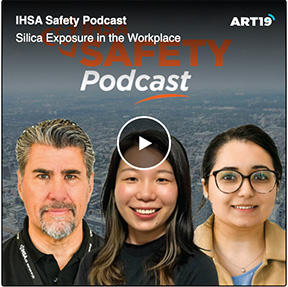 Another Year of Popular Podcasts
Another Year of Popular Podcasts
OHCOW has created seven podcasts in the 23/24 fiscal year, and participated in an eighth with the IHSA. Ranging in topics covering ergonomics and occupational hygiene, OHCOW's podcasts have become increasingly popular, enjoying an expanding audience. See our extensive list of podcast links here.
Number of Downloads for the Year: 671
Top Podcast: The Dangers of Silica in the Workplace
Partnership
The Silica Control Tool partnered with the IHSA to inform the audience about the Silica Control tool Episode 69: Silica Exposure in the Workplace. In this episode of the IHSA Safety Podcast, Jasmine Kalsi, IHSA’s Occupational Hygienist, and Shirly Yan, Occupational Hygienist at the Occupational Health Clinics for Ontario Workers (OHCOW)—Toronto Clinic, discuss the hazards posed by silica in construction.
Hear our most recent Ergonomics Podcast:
Ergonomics is the scientific discipline of fitting the job or task to the physical dimensions, physical abilities, and mental capabilities of the worker – matching the job to the person. The goal of Ergonomic intervention is to identify, minimize, and eliminate hazards (or risk factors) that may contribute to the onset of musculoskeletal injuries. In this podcast we discuss Ergonomics, Ergonomic risk factors, and Musculoskeletal Disorders (MSDs), as well as how identifying, assessing, and implementing ergonomic controls can help with injury prevention. Hear the podcast.

Celebrated in October each year, Global Ergonomics Month is an international outreach campaign promoting human-centred design through the science, application and profession of ergonomics or human factors. These disciplines are focused on optimizing human well-being as well as overall system performance by proactively designing work and work systems to fit the people interfacing with them in ways that improve efficiency, productivity, health, safety and comfort.
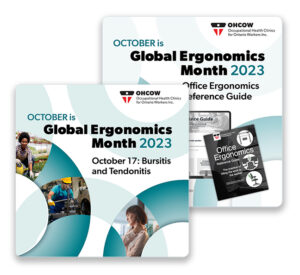 In October 2023, Global Ergonomics Month, OHCOW highlighted through our social media channels various resources throughout the month to raise awareness and provide information on the benefits of ergonomics. Ergonomics is ultimately good for both business and people.
In October 2023, Global Ergonomics Month, OHCOW highlighted through our social media channels various resources throughout the month to raise awareness and provide information on the benefits of ergonomics. Ergonomics is ultimately good for both business and people.
For the month of October OHCOW ergonomists published pdf and electronic resources such as various MSD Info Sheets, link to a recent podcast entitled The Role of a MLITSD Ergonomist featuring a discussion with Amir Estulin, and the Office Ergonomics Reference Guide.
OHCOW's popular tools and calculators are always being updated for ease of use and to reflect changing factors in work environments. In the past year, some tools that were previously just available on an Excel Sheet are now moved to the web and apps are available, for both I0S and Google platforms.
Calculators
The Office Ergo Calculator, Anthropometric Calculator, and Cold Stress Calculator have all been updated and revised. Previously they were downloadable programs in Excel or Power Point. Errors could occur in these calculators depending on repeated opening of the page and Windows security features. Use of the calculators did not require login and information could not be tracked or updated.
The Cold Stress, Anthropometric and Office Ergo Calculators are now in a web based format and a mobile APP exists for each. The Anthropometric Calculator has improved graphics and re-organization of tables, and can now be exported to the Office Ergo Calculator. The Office Ergo Calculator has improved audio, graphics, and video. Its options now include metric or imperial measurements, keyboard tray selection (height adjustable, on desk), and dual monitors. Variables now include monitor distance and arm length.
Keyboard Shortcut Tutorial
The Keyboard Shortcut Tutorial was PowerPoint based and in the latest update was turned into a web-based format with a mobile app and enhanced video and graphics. A landing page allows the user an introduction to the tool and choice of operating system (Mac or Windows) and Language (English or French).
A New OHCOW Service Makes Learning Easier
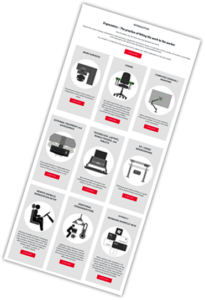 Office ergonomics is more important now than it has ever been before in our efforts to decrease and/or eliminate musculoskeletal disorders. Many workplaces do not have the financial resources (or time) to correctly train their workers in ergonomics, and specifically to identify and correct office set-up and use challenges. Building on the popular Office Ergonomics Ergo Reference Guide, the Office Ergonomics e-Learning Course breaks down the key ergonomic principles of workstation components into modules that allow users to progress at their own pace, while learning how to recognize, assess, and control the ergonomic hazards related to computer work wherever it is done.
Office ergonomics is more important now than it has ever been before in our efforts to decrease and/or eliminate musculoskeletal disorders. Many workplaces do not have the financial resources (or time) to correctly train their workers in ergonomics, and specifically to identify and correct office set-up and use challenges. Building on the popular Office Ergonomics Ergo Reference Guide, the Office Ergonomics e-Learning Course breaks down the key ergonomic principles of workstation components into modules that allow users to progress at their own pace, while learning how to recognize, assess, and control the ergonomic hazards related to computer work wherever it is done.
Job Assess
A new web-based app from OHCOW that allows you to accurately and efficiently capture the Physical, Sensory, Cognitive and Psychosocial demands of any job. This new online tool allows you to select the demands that are relevant to the job you are assessing and then steps you through each and every section in detail. After creating a quick job profile, you set up the relevant tasks and assign the various task elements. You can even include photos to enhance the job record. Additional sections include:
- Administrative Considerations
- Personal Protective Equipment (PPE)
- Tools, Equipment, and Materials
- Environmental Considerations
- Strength Demands
- Body Posture Frequency
- Sensory Demands
- Cognitive Demands
- Psychosocial Factors
You use simple checklists, picklists and text fields to enter information and you can even red flag items that are of concern.
Once all sections are finalized, you are presented with a complete Job Demands Analysis (JDA) that can be saved for future re-use and downloaded as a PDF for reference and record keeping purposes.
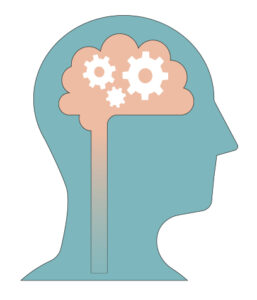 Workplace Mental Health
Workplace Mental Health
One of the biggest challenges for workplaces today is achieving a balance between the demands of work and employees' mental health and wellness. OHCOW offers tools, webinars and other resources to help employers address the crucial issue of workplace stress, and employees to discover how they can advocate for better conditions.
May 3, 2023
 Opioid Addiction and Impairment Prevention at Work
Opioid Addiction and Impairment Prevention at Work
The first session addresses current concern in many workplaces and a Provincial OHS priority. Discussion includes the complexity of factors involved, plus resources to help. Opioid and substance misuse in the Building Trades is the first topic, and looks at a strategy to deal with an epidemic. Opioid-harms among Ontario Workers is examined and a re-examination of substance use impairment in workplaces entitled Moving the “dial” from zero tolerance to harm reduction and support.
May 10, 2023
COPSOQ Joint Session – Research into Practice
OHCOW hosted the biannual COPSOQ (Copenhagen Psychosocial Questionnaire) Network meeting in Hamilton on May 11 & 12. See below section for detailed information on this in-person event.
May 17, 2023
 Youth Mental Health in the Community and at Work
Youth Mental Health in the Community and at Work
Young workers have recognized vulnerabilities to workplace injuries & harms, including to psychosocial risk factors, made worse in the pandemic. Learn more about challenges faced by these frequently exposed front-line staff in their daily jobs, and some solutions to reduce risk and mitigate harm from an agency, industry and advocacy perspective.
May 24, 2023
 Crisis Planning for Worker & Responder Mental Health
Crisis Planning for Worker & Responder Mental Health
This session examines raising awareness and recognizing planning and operational strategies that can make a difference in the short & long term impact of trauma. Topics include A Safety Professional’s Experience with Mental Health and PTSD from a public safety perspective. The question of providing mental health support with the program PeerOnCall @ work: in the palm of your hand. Experts also discuss worker trauma support planning in Crisis management.
May 31, 2023
 Workplace Mental Health Programs and Opportunities
Workplace Mental Health Programs and Opportunities
Wrapping up this important webinar series with a focus on success strategies, tools and other resources to support workers and workplaces.
Session 2: COPSOQ Joint Session – Research into Practice
A unique opportunity to look at the international use and impact of the Copenhagen Psychosocial Questionnaire, an important workplace mental health/stress prevention survey tool
OHCOW hosted the biannual COPSOQ (Copenhagen Psychosocial Questionnaire) Network meeting in Hamilton on May 11 & 12 that discussed the technicalities of the survey and its use around the world. It was scheduled it in May to intersect with our annual Mayday, Mayday Symposium on Workplace Mental Health and Injury Prevention. Research into Practice is a combined event including our regular audience of worker activists and advocates, Workers Compensation and OHS professionals, regulators, and researchers as well as others interested in the COPSOQ from around the world. This is one of three virtual sessions as a complement to the full-day, in-person* Joint COPSOQ & OHCOW Network Meeting in Hamilton, ON.
The 9th International Workshop on the Copenhagen Psychosocial Questionnaire was to discuss the technicalities of the survey and its use around the world, took place in Hamilton, Ontario. The Copenhagen Psychosocial Questionnaire has been used in thousands of enterprise-based risk assessments of psychosocial factors and in many scientific research projects including comparative studies among various countries in Europe and abroad. To learn more about COPSOQ, see their web site.
The virtual sessions:
 A. Canadian Survey Results and Trends
A. Canadian Survey Results and Trends
John Oudyk hosts three of the sessions on Canadian National Survey Results & Trends: How Stressed are We?, The Big Picture, Data Analysis, Details and Patterns, and Finding trends – Comparing 2016, 2019 and Today The Current Story – Qualitative Comments, Daryl Stephenson. It is followed by a discussion includes the audience.
 B. Survey Use and Challenges in Canada
B. Survey Use and Challenges in Canada
In the first session entitled StressAssess Success Stories, representatives from the Burlington Family Health Team, Infrastructure Health and Safety Association, and the Ontario Nurses Association share their stories of using OHCOW's StressAssess tool in their workplaces. Short /”Pulse” survey experience, includes a Research update, Hanne Berthelsen, Dr. Odont., MPH, DDS, Associate Professor/Researcher, Malmö University and a Case Study, John Oudyk. Pre-Survey Planning, Trust and Engagement Challenges, Geoffrey Thompson, MPH, Occupational Health Nurse, Occupational Health Centre, Manitoba
 C. Workplace Mental Health Survey Use Around the World
C. Workplace Mental Health Survey Use Around the World
New US Healthy Worker Survey Update, Dr. Marnie Dobson, International Survey Highlights, COPSOQ Network Panel Discussion: Use of WMH Surveys given existential risks like war, disease and climate change?
Worker Perspective
Foreign workers, in the agricultural and other industries, are a vital and necessary element of the workforce in Ontario. They have the same rights to safe and healthy workplaces as any Canadian. Because of language and cultural barriers, it can be challenging to create comfortable and safe environments for them, and to impart to them the information they need to know about working in Canada. OHCOW's Temporary Foreign Workers team has been assisting these workers with in-person services and the distribution of print and other media in their language. Resources for employers and worker advocates are also provided by OHCOW.
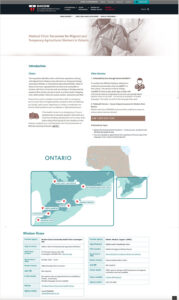 In June of 2023, a page was added to the Temporary Foreign Workers section of the web site, featuring an interactive map showing the locations of clinics where migrant workers can get treatment. Used by health workers, employers and advocates, the page allows instant access to information about the hours and services of each clinic, as well as other information.
In June of 2023, a page was added to the Temporary Foreign Workers section of the web site, featuring an interactive map showing the locations of clinics where migrant workers can get treatment. Used by health workers, employers and advocates, the page allows instant access to information about the hours and services of each clinic, as well as other information.
Ensuring the health and well-being of migrant workers is a priority for OHCOW. Receiving medical attention when required is a fundamental right for those working in Ontario.
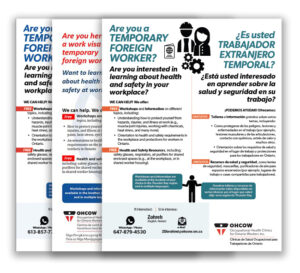 Titled Are You a Temporary Foreign Worker and appearing in three languages, these resources are meant for those interested in learning more about health and safety in their workplaces. Available in English, Spanish and Tagalog, they provides information on free resources and workshops being held in various regions in Ontario.
Titled Are You a Temporary Foreign Worker and appearing in three languages, these resources are meant for those interested in learning more about health and safety in their workplaces. Available in English, Spanish and Tagalog, they provides information on free resources and workshops being held in various regions in Ontario.
These materials are available in English, French, Spanish, Ukranian, Vietnamese, Tigringna, Arabic and Dari. Wallet-size reference cards contain helpful information for new / young workers who need to exercise their rights for a healthy and safe work environment. There are also Youtube videos explaining the cards in each language.

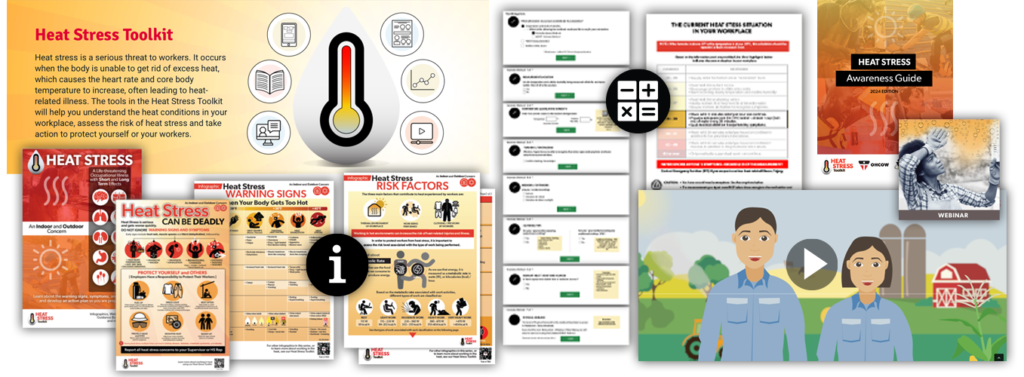
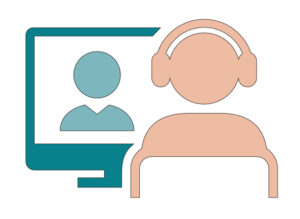
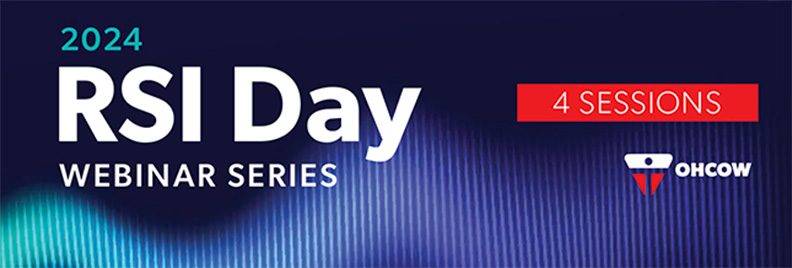


 Aimed at temporary and foreign workers, the following resources provide detailed information about calling 911 when you require emergency services. They are provided in multiple languages, and presented as videos and info sheets.
Aimed at temporary and foreign workers, the following resources provide detailed information about calling 911 when you require emergency services. They are provided in multiple languages, and presented as videos and info sheets.